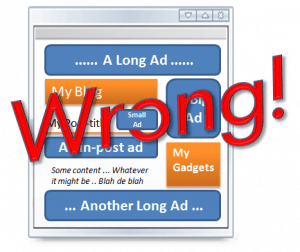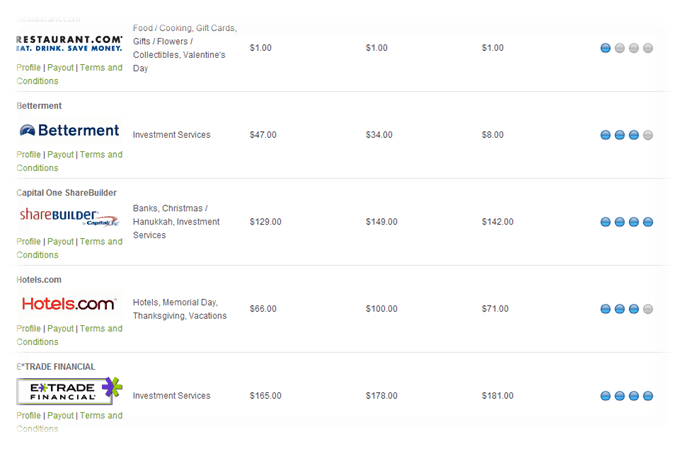For anyone reading this who is not a blogger, here’s what we’re talking about: Affiliate marketing is when you put ads on your website. Those links can either be in the form of images or just simple text. When a reader clicks on the link and either fills out a form or completes a sale, that results in a commission for the website owner.
Get enough of the right kind of visitors to come to your site and click around, and you’ve got a potential gold mine on your hands!
My Failed History with Affiliate Marketing:
Before long I started trying a different approach. I began writing whole articles about a specific product such as a credit card offer or something along those lines. That was probably better, but again it felt spammy. I was as if I was writing a terrible late-night infomercial or scripting the dialogue of a poorly executed QVC ad spot. In the end, it didn’t matter how I felt about it – no sales were happening.
And then I decided to just pull back on advertising altogether by only having a few ads on the sidebars and some Google Adsense. I wanted to change my priorities and really focus more on the development of my site.
Getting Back on the Horse:
Now that some time has passed and Google has outlawed the practice of private advertising, I find myself again at the drawing board looking at my options for growing the income that this blog produces. And since I have no eBook, product, or unique service to pitch, I’m again warming up to the idea of affiliate marketing.
I KNOW people can have success with this. There are a number of blogs you read where people do a very good job pushing their opinions about certain things, and it appears to pay off for them tremendously. John Chow is one example. Even everyone’s beloved Pat Flynn from Smart Passive Income makes a killing with affiliate income. Just look at any of his income reports.
So are you really a bad guy if you use affiliate marketing to make a buck? Of course not. But like in all things, it’s less about “what you say” and more about “the way you say it”. Here’s what I mean by that…
The Elements of Affiliate Marketing:
The thing I’ve noticed about affiliate marketing is that it is best done when you least expect it. Whenever I get an email or read a blog post that is centered around a problem someone is having, and they draw your attention towards the undeniable conclusion that some affiliate product will easily solve my problem, sometimes I barely notice.
But why is that?
- Is it because they persuaded me so?
- Is it because I trust this writer?
- Is the product so good that it naturally sells itself?
- Or is it because I NEED that solution so bad that I’m willing to give it a try?
Perhaps it is a combination of all of these. But essentially what is happening is we have the perfect storm of matching up a great product offering with the right target audience.
The Latest of My Affiliate Marketing Ideas:
Notice there are two elements to the above statement:
- Target audience
- Great product offering
How can I apply this knowledge to achieve more income with my blog? Perhaps Google Webmaster Tools can help me with the first part.
Step 1 – Which Posts Get the Most Traffic?
In case you don’t have one already, signing up for a Google Webmaster Tools account is invaluable because they basically tell you how many people are clicking on your pages, which search terms took them to your site, your relative rank within the Google searches, and a whole lot more.
Since I already have an account, the first place I’m going to look is the “Search Queries”. There I’ll find a complete list of all the terms my posts are ranking for, the average SERP rank, and the click through rate (CTR).
For my intentions, the combination of CTR and Impressions will be the most important factors. A high CTR means that the post for whatever reason was interesting enough for someone to read the title or read the meta description, and click on the post. But it is also important to keep this in context with how many people are actually clicking through; hence the Impressions. For example, compare the second and third lines in the screen shot.
Together, this is very valuable information. These are the posts that people are ACTUALLY reading.
If you were going to put up an advertisement on a street corner, wouldn’t you want the ones that get a high amount of traffic versus no traffic at all? That’s exactly how I view finding the posts that get the most clicks.
Step 2 – Insert the Proper Affiliate Product:
Among these posts that get the most traffic, what are they about? Obviously this blog is about money, but what specific money topic? Retirement? Investing? Saving? Budgeting?
Once I have these specific topics, I then go to my plate of potential Affiliate marketing products to offer. Obviously there are hundreds of places where you can find affiliate marketing products to offer. Each one will have its own unique pros and cons such as payout, cookie life, reputation, etc. It is usually a personal choice as to what products you’d like promote. It also certainly helps if you’ve actually used that product in the past with favorable experiences. For whatever reason I choose to use Flex Offers for my affiliate product choices.
Getting back to our highly visited posts, which of these affiliate products would match the content of your posts? For example, I usually have a number of posts with a high CTR that are about preparing for retirement. When this happens, I will usually insert an advertisement for Betterment.com. Betterment is a great idea for a retirement service, and anyone who is looking to learn more about retirement may find that product intriguing. SEO tip: Always “nofollow” the link to an affiliate.
Once I insert that advertisement into the blog post, I’ve now incredibly increased the visibility of those ads and chances to make passive income.
Step 3 – Review the Results:
Probably once a month I will plan to perform this cycle and then repeat. The things I will be looking for:
- Did the products sell? I may receive more clicks on the ads, but will that result in more conversions (sales)? If not, perhaps I’m pushing the wrong the products and need to try something different.
- Are my posts still popular? Maybe the traffic I experience to one post or another was only temporary and other blogs posts are now receiving good CTR. Now I need to make sure I capitalize on those posts to appropriately capture the opportunity.
- Am I doing the best I can? This will probably be one of the most important “behind the scenes” steps I can take to really improve my luck. Suppose I look at my Google Webmaster Tools and have blog posts that rank in the top 10, have high search volume, BUT receive little to no CTR. What the heck? What am I doing wrong? Maybe my post title is boring. Maybe my meta description is lame. What if I was to tweak one of these details in an attempt to get some more attention? This is a relatively simple thing that could have profound results. If you’d like to explore this technique further, Matt from Dumb Passive Income has an excellent step by step post on how to single out your old posts for certain keywords and then go back to optimize them better.
More Marketing Ideas:
At some point I’ll also explore an off-blog marketing initiative to use my subscriber list to sell affiliate products. Right now I’m doing as much research as I can to help myself excel at this effort. It’s important to remember that you don’t have to do everything on your own. There are plenty of good books and resources you can consult on this topic. There are also good paid consultants you can speak to.
The Importance of SEO:
Since this strategy relies on organic traffic, we again find ourselves reminded of how important it is to follow good SEO practices. That doesn’t mean robo-writing a post just for a certain keyword. You can write about whatever you want and how ever you want. But you can’t deny that picking good keywords is beneficial. So is picking a good title, meta description, headers, images, links, etc. All of these things will naturally help get your posts found. And getting found is the first step to someone taking the next step to making some kind of income.
Readers – What are your affiliate marketing ideas and suggestions? What works or doesn’t work for you?
Image courtesy of FreeDigitalPhotos.net






OMG! Why haven’t I thought of this before? I am not signed up for a a webmaster account but I am going to get on that pronto. This is a great idea. How has this went for you so far?
I’ve only used it on a few of the very top pages. I make about one sale per month, which isn’t anything to brag about. But I have a feeling I might do better if I apply this to all the posts with click-through and vary the ads.
My best tip over the years has been to provide a super-helpful article, and then list some tools. The tools is where you make your money and the readers benefit as well 🙂
Good tactic. I feel like a lot of the times I’ve been swayed to buy something it was usually the result of someone really needling in on an issue I was having and then offering the said product up as a worthy solution.
Great post. I also believe when you are promoting other people’s product it is best you use them yourself as this gives more credibility to your audience. Building a trust takes a long time to build and it can easily go away in a second.
Thanks Kevin. Although I don’t think you need to try every product, I think it certainty helps you to be a better salesmen if you do. You can always draw from experience and really talk up the benefits of the affiliate.
Great ideas and tips on affiliate marketing. I did the exact same mistakes from the very beginning. I had no traffic, but my website was clogged with banners and ads “in every square pixel” (I wouldn’t say inch here 🙂 )
I am glad that I am following the right track by stepping down and having no ads as long as my website improves, gets more traffic and more visitors and as well as my writing gets better.
You are doing an excellent job with your web. I kinda envy you and trying to follow your advice.
Thanks Martin. I hope I can create some success with this process so that you can know these tips will work well for you.
That is a good take on affiliate marketing. The average person will spend a little bit of money online over the course of a month. The money they spend could be on Amazon, Priceline, Hotels.com or any other number of sites. If you present your audience with some type of “deal” for products and services that they are using anyways, then you are not just affiliate marketing…you are actually doing your audience a favor by saving them money.
Thanks Zimmy. It is my belief that as time goes on a lot more people will be willing to spend and make transactions over the Internet. I feel like getting in on the scene even now is still a good idea. The more good deals and products I can promote the more I can capitalize it. It might as well be me since someone will make money from it.
All great tips MMD. One thing I try to do when I’m promoting an affiliate product is to think about all the questions someone who wants to own that product know.
For example, they might want to know how much it cost, how it works, or even if it’s worth it. From their I will write a post about each of these questions instead of doing an entire review of the product but rather just answer that one specific question.
I will also say that it’s much easier to rank for most of these terms rather trying to rank for a product review, at least this has been my experience with selling affiliate products.
It’s been a long time since I’ve written a post specifically for a certain product. But I’m open to giving it a try. I have noticed from my keyword research that specific brands and companies often rank lower in competition since almost no one wants to touch them when they write naturally. This could be a good opportunity for us …
These are exceptional views and ideas about getting best relevant audience. Thanks for providing these fantastic ideas. 🙂
Thanks Aman and welcome to the site!
Great tips on affiliate marketing. In addition, to take these methods a step further. Once you have found a niche topic and product that sells well. Create a microsite on the particular term/phrase that produces good traffic and converts well.
A dedicated site on the theme, can help conversion rates because its essentially a specialist site and it has the ability to rank higher and longer with in the search engines. granted you have decent SEO skills and maintain a program to keep the site relevant.
Great article though – good topic
A number of people now have commented on building a microsite for a particular niche product. This intrigues me because I’ve probably stumbled across a dozen of these types of sites in the past without ever thinking about it. Perhaps I will attempt this one in the future as a type of experiment. Thanks for the suggestion.
Great ideas and as always, well written. I certainly could improve in all those areas.
Thanks Kim! Now I just have to remember to take my own advice and stay on top of this process.
Great post MMD! I remember promoting products and I thought by just putting up big banners and saying click here people would buy. It wasn’t until people trusted what I was saying and got to know me that I was actually making money. But it was less of a sale through selling. The more I talked about the use of the products the plus and minus of each and gave realistic accounts the more sales I got.
People want real results and can tell the difference between being sold to versus being helped. I agree – banners all over don’t really do much for you. You’ve got to make it part of what that audience needs and is looking for. Once they’ve got the inside scoop on a product, they’ll be more interested in trying it out for themselves.
Great informative post as usual. Some good tips there like the bit about Google Webmaster Tools – had I known that years ago it would have saved me a lot of pain and ache. But I guess all affiliates need to go through the initial heartache – those that don’t give up and move onto the “next shiny thing” are the ones that succeed….realistically it can take a very long time to build up a decent income.